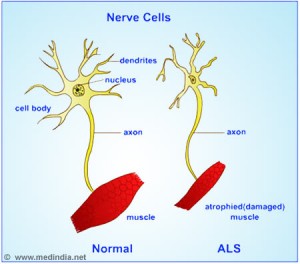About this time last year, you may have seen millions of videos on social media: people were pouring buckets of ice water over them, nominating others to either take the challenge itself or financially to help fight ALS. Until I saw one of those videos, I, personally, didn’t have any clue what they were doing. Yet, I had no scientific knowledge about ALS.
ALS (Amyotrophic lateral sclerosis), often called as Lou Gehrig’s disease, is a progressive neurodegenerative disease which causes motor nerve cells in the brain and spinal cord to degenerate. Eventually, the brain becomes impossible to initiate and control muscle movement. Patients in the beginning stage may experience difficulties with breathing, swallowing, and speaking. Later in the stage, patients become completely paralyzed. Stephen Hawking, one of the most recognizable scientists, was diagnosed with slow-progressing form of ALS in his early age. Most people who develop ALS are in between the age 40 and 70, but there are cases occurring in twenties and thirties. For more information of how it is like living with ALS, check the video below:
Credit: Roundabout U
According to an article from Johns Hopkins Medicine, ALS affects nearly 30,000 people in the United States. Every year about 5,000 people are diagnosed with ALS. Through the Ice Bucket Challenge, one of the most powerful examples of social media movement, the number of people, politicians, celebrities, and CEOs participated in this challenge, luring attention to the society. There was one of the key important message embedded in the ice bucket challenge. The idea of challenging people to douse themselves in cold water help them indirectly experience muscle contraction, just like how the ALS patients are going through.
According to the article from Time magazine, ALS Association (ALSA), has received over $115 million in donations. ALSA allocated towards a number of research, community services and patients to improve the quality of lives. So far, it has spent about $47 million. Two-thirds of them were spent toward various researches of gene discovery, drugs and disease model development, and identification of biomarkers. 20% of the donations have been spent on patients and community services, and 11% on fundraising and education. According to ALSA, 79% of their budget was spent toward services and programs, and 28% of that was on research.
Recently, researchers have found a protein, TDP-43. This is what ALS patients fail to have in their cells and if they repair this protein, the damaged cells in ALS can restore. Researchers are hoping to see if this method can be applied to many diseases that weaken muscles, such as Alzheimer’s and Parkinson’s diseases. Without those funds, it would have been difficult to demonstrate this high-risk-high-return experiment. Through social media, ALSA has been able to draw the attention to this “incurable” disease for further research and education. Hopefully soon in the future, TDP-43 becomes a key to many neuromuscular disorders and therefore cure many patients.
Posted By: Josephina (KyungBin) Kim


